Spatial and Temporal Variations’ Characteristics of Extreme Precipitation and Temperature in Jialing River Basin—Implications of Atmospheric Large-Scale Circulation Patterns
Abstract
1. Introduction
2. Materials and Methods
2.1. Study Area
2.2. Data
2.3. Extreme Precipitation and Extreme Temperature Index Descriptions and Definitions
2.4. Atmospheric Circulation Index
2.5. Mann–Kendall (M-K) Trend Method
2.6. Correlation Analysis
2.6.1. Pearson Correlation Analysis
2.6.2. Wavelet Coherence Analysis (WTC)
3. Result and Discussion
3.1. Interannual Trends in Extreme Precipitation and Atmospheric Temperature in JRB
3.2. Characterization of Spatial and Trend Changes in Extreme Precipitation and Atmospheric Temperature in JRB
3.3. Linear Correlation between Extreme Climate and Atmospheric Circulation in the JRB
3.4. Nonlinear Correlation between Extreme Climate Index and Atmospheric Circulation in JRB
4. Conclusions
Author Contributions
Funding
Data Availability Statement
Conflicts of Interest
References
- Ai, X.; Han, Z.; Zhang, Q. Extreme Weather Experience and Climate Change Risk Perceptions: The Roles of Partisanship and Climate Change Cause Attribution. Int. J. Disaster Risk Reduct. 2024, 108, 104511. [Google Scholar] [CrossRef]
- Patwary, M.M.; Bardhan, M.; Haque, M.A.; Moniruzzaman, S.; Gustavsson, J.; Khan, M.M.H.; Koivisto, J.; Salwa, M.; Mashreky, S.R.; Rahman, A.K.M.F.; et al. Impact of Extreme Weather Events on Mental Health in South and Southeast Asia: A Two Decades of Systematic Review of Observational Studies. Environ. Res. 2024, 250, 118436. [Google Scholar] [CrossRef] [PubMed]
- Vo, T.-H.; Liou, Y.-A. Four-Decade Spring Droughts in Taiwan. J. Hydrol. Reg. Stud. 2024, 54, 101849. [Google Scholar] [CrossRef]
- Zhu, Y.; Song, F.; Guo, D. Interdecadal Changes in the Frequency of Winter Extreme Cold Events in North China during 1989–2021. Atmos. Ocean. Sci. Lett. 2024, 17, 100468. [Google Scholar] [CrossRef]
- Richards-Thomas, T.S.; Déry, S.J.; Stewart, R.E.; Thériault, J.M. Climatological Context of the Mid-November 2021 Floods in the Province of British Columbia, Canada. Weather Clim. Extrem. 2024, 45, 100705. [Google Scholar] [CrossRef]
- Luedders, J.; Poole, J.A.; Rorie, A.C. Extreme Weather Events and Asthma. Immunol. Allergy Clin. N. Am. 2024, 44, 35–44. [Google Scholar] [CrossRef] [PubMed]
- Rostami, M.; Green-Mignacca, S.; Bucking, S. Weather Data Analysis and Building Performance Assessment during Extreme Climate Events: A Canadian AMY Weather File Data Set. Data Brief 2024, 52, 110036. [Google Scholar] [CrossRef] [PubMed]
- Zhang, W.; Liu, L.; Li, X.; Cheng, L.; Cheng, Y.; Li, H. Intensified Response of Extreme Precipitation to Rising Temperature over the Tibetan Plateau from CMIP6 Multi-Model Ensembles. J. Hydrol. 2024, 637, 131397. [Google Scholar] [CrossRef]
- Xu, F.; Zhao, L.; Zhou, Y.; Yang, J.; Jing, W.; Deng, Y.; Li, Z. Impacts of Extreme Precipitation on Water Conservation in Beijiang River Basin, China. J. Hydrol. 2024, 637, 131299. [Google Scholar] [CrossRef]
- Sun, P.; Bian, Y.; Yu, S.; Yao, R.; Wang, Z.; Zhang, Q.; Chen, W.; Ge, C.; Ma, Z.; Du, W. Are Longer and More Intense Heatwaves More Prone to Extreme Precipitation? Glob. Planet. Chang. 2024, 236, 104428. [Google Scholar] [CrossRef]
- Ren, Z.; Zhao, H.; Shi, K.; Yang, G. Spatial and Temporal Variations of the Precipitation Structure in Jiangsu Province from 1960 to 2020 and Its Potential Climate-Driving Factors. Water 2023, 15, 4032. [Google Scholar] [CrossRef]
- Xu, Q.; Jiao, J.; Yan, Z.; Liao, J.; Zhang, Z.; Li, M.; Yan, X.; Chen, Y.; Li, J.; Jian, J. Response of Road Erosion to Hydrological Connectivity under a Heavy Rainstorm in an Agricultural Watershed on the Loess Plateau. CATENA 2024, 240, 107991. [Google Scholar] [CrossRef]
- Sun, J.; Liu, T.; Xie, S.; Xiao, J.; Huang, L.; Wan, Z.; Zhong, K. Will Extreme Temperature Events Emerge Earlier under Global Warming? Atmos. Res. 2023, 288, 106745. [Google Scholar] [CrossRef]
- Chikoore, H.; Mbokodo, I.L.; Singo, M.V.; Mohomi, T.; Munyai, R.B.; Havenga, H.; Mahlobo, D.D.; Engelbrecht, F.A.; Bopape, M.-J.M.; Ndarana, T. Dynamics of an Extreme Low Temperature Event over South Africa amid a Warming Climate. Weather Clim. Extrem. 2024, 44, 100668. [Google Scholar] [CrossRef]
- Yu, M.G.; Mukherjee, M.; Poudel, S.; Bender, S.R.; Hanif, S.; Hardy, T.D.; Reeve, H.M. A Valuation Framework for Customers Impacted by Extreme Temperature-Related Outages. Appl. Energy 2024, 368, 123450. [Google Scholar] [CrossRef]
- Zohrabi, N.; Massah Bavani, A.; Goodarzi, E.; Eslamian, S. Attribution of Temperature and Precipitation Changes to Greenhouse Gases in Northwest Iran. Quat. Int. 2014, 345, 130–137. [Google Scholar] [CrossRef]
- Li, H.; He, S.; Yuan, X.; Liu, Y.; Yan, Y. The Contrast Responses of August Precipitation over Northeast China to Strong and Moderate Developing El Niño. Atmos. Res. 2024, 304, 107378. [Google Scholar] [CrossRef]
- Wang, F.; Lai, H.; Men, R.; Sun, K.; Li, Y.; Feng, K.; Tian, Q.; Guo, W.; Du, X.; Qu, Y. Spatial and Temporal Evolutions of Terrestrial Vegetation Drought and the Influence of Atmospheric Circulation Factors across the Mainland China. Ecol. Indic. 2024, 158, 111455. [Google Scholar] [CrossRef]
- Sun, W.; Li, J.; Yu, R.; Li, N.; Zhang, Y. Exploring Changes of Precipitation Extremes under Climate Change through Global Variable-Resolution Modeling. Sci. Bull. 2024, 69, 237–247. [Google Scholar] [CrossRef]
- Dong, H.; Huang, S.; Wang, H.; Shi, H.; Singh, V.P.; She, D.; Huang, Q.; Leng, G.; Gao, L.; Wei, X.; et al. Effects of Interaction of Multiple Large-Scale Atmospheric Circulations on Precipitation Dynamics in China. Sci. Total Environ. 2024, 923, 171528. [Google Scholar] [CrossRef]
- Gao, M.; Yang, Y.; Shi, H.; Gao, Z. SOM-Based Synoptic Analysis of Atmospheric Circulation Patterns and Temperature Anomalies in China. Atmos. Res. 2019, 220, 46–56. [Google Scholar] [CrossRef]
- García-Burgos, M.; Gómara, I.; Rodríguez-Fonseca, B.; González-Alemán, J.J.; Zurita-Gotor, P.; Ayarzagüena, B. Abrupt and Persistent Atmospheric Circulation Changes in the North Atlantic under La Niña Conditions. Weather Clim. Extrem. 2023, 42, 100609. [Google Scholar] [CrossRef]
- Jong, S.-I.; Pak, Y.-I.; Om, K.-C.; Ham, Y.-S.; Kim, H.-U.; Paek, U.S. An Abrupt Change of Winter Surface Air Temperature over the Northern Part of Korean Peninsula in the Late 1980s and Related Atmospheric Circulation Variability. Atmos. Res. 2023, 290, 106803. [Google Scholar] [CrossRef]
- Lorenzo-Lacruz, J.; Morán-Tejeda, E.; Vicente-Serrano, S.M.; Hannaford, J.; García, C.; Peña-Angulo, D.; Murphy, C. Streamflow Frequency Changes across Western Europe and Interactions with North Atlantic Atmospheric Circulation Patterns. Glob. Planet. Change 2022, 212, 103797. [Google Scholar] [CrossRef]
- Ren, Y.; Xia, J.; Zeng, S.; Song, J.; Tang, X.; Yang, L.; Lv, P.; Fan, D. Identifying Critical Regions for Nitrogen and Phosphorus Loss Management in a Large-Scale Complex Basin: The Jialing River. Environ. Res. 2023, 232, 116359. [Google Scholar] [CrossRef] [PubMed]
- Chen, Y.; Ran, Y.; Chen, F.; Wang, S.; Hu, M.; Hou, T.; Zhao, X.; Yue, W.; Zhang, H. Examining the 2022 Drought Event in the Past and Future Discharge Changes of the Upper Jialing River from a Tree-Ring Perspective. J. Hydrol. Reg. Stud. 2024, 53, 101824. [Google Scholar] [CrossRef]
- Wang, Y.; Liang, L.; Chen, X.; Zhang, Y.; Zhang, F.; Xu, F.; Zhang, T. The Impact of River Sand Mining on Remobilization of Lead and Cadmium in Sediments—A Case Study of the Jialing River. Ecotoxicol. Environ. Saf. 2022, 246, 114144. [Google Scholar] [CrossRef]
- Xu, F.; Jia, Y.; Wang, Y.; Zhang, F.; Li, L.; Li, Y.; Ren, L.; Wang, D.; Zhang, T. Does Sand Mining Affect the Remobilization of Copper and Zinc in Sediments?—A Case Study of the Jialing River (China). Environ. Res. 2021, 200, 111416. [Google Scholar] [CrossRef]
- Zhang, S.; Li, W.; An, W.; Hou, J.; Hou, X.; Tang, C.; Gan, Z. Temporal and Spatial Evolutionary Trends of Regional Extreme Precipitation under Different Emission Scenarios: Case Study of the Jialing River Basin, China. J. Hydrol. 2023, 617, 129156. [Google Scholar] [CrossRef]
- Yu, J.; Zou, L.; Xia, J.; Dou, M.; Wang, F.; Chen, X. Characterizing Future Changes in Compound Flood Risk by Capturing the Dependence between Rainfall and River Flow: An Application to the Yangtze River Basin, China. J. Hydrol. 2024, 635, 131175. [Google Scholar] [CrossRef]
- Multi-Timescale Changes of Water Temperature Due to the Three Gorges Reservoir and Climate Change in the Yangtze River, China. Ecol. Indic. 2023, 148, 110129. [CrossRef]
- Sun, J.; Lei, X.; Tian, Y.; Liao, W.; Wang, Y. Hydrological Impacts of Climate Change in the Upper Reaches of the Yangtze River Basin. Quat. Int. 2013, 304, 62–74. [Google Scholar] [CrossRef]
- Wang, Y.; Gong, J.; Zhu, Y. Integrating Social-Ecological System into Watershed Ecosystem Services Management: A Case Study of the Jialing River Basin, China. Ecol. Indic. 2024, 160, 111781. [Google Scholar] [CrossRef]
- Gemmer, M.; Becker, S.; Jiang, T. Observed Monthly Precipitation Trends in China 1951–2002. Theor. Appl. Climatol. 2004, 77, 39–45. [Google Scholar] [CrossRef]
- Sun, Y.; Zhu, R.; Wang, T. Projection of Extreme Climate Change in the Asian Arid Region and the Tibetan Plateau in the Early and Middle 21st Century Based on NEX-GDDP-CMIP6. Atmos. Ocean. Sci. Lett. 2024, 100534. [Google Scholar] [CrossRef]
- Dong, Y.; Zhai, J.; Zhao, Y.; Liu, Z.; Yang, Q.; Jiang, S.; Lv, Z.; Yan, D.; Liu, K.; Ding, Z. Impacts of Large-Scale Circulation Patterns on the Temperature Extremes in the Cold Regions of China with Global Warming. Front. Earth Sci. 2023, 11, 1120800. [Google Scholar] [CrossRef]
- Jalkanen, L. WMO/IGAC Impacts of Megacities on Air Pollution and Climate. Urban Clim. 2012, 1, 67–68. [Google Scholar] [CrossRef]
- Fattah, M.A.; Hasan, M.M.; Dola, I.A.; Morshed, S.R.; Chakraborty, T.; Kafy, A.-A.; Alsulamy, S.; Khedher, K.M.; Shohan, A.A.A. Implications of Rainfall Variability on Groundwater Recharge and Sustainable Management in South Asian Capitals: An in-Depth Analysis Using Mann Kendall Tests, Continuous Wavelet Coherence, and Innovative Trend Analysis. Groundw. Sustain. Dev. 2024, 24, 101060. [Google Scholar] [CrossRef]
- Huang, R.; Hanif, M.F.; Siddiqui, M.K.; Hanif, M.F. On Analysis of Entropy Measure via Logarithmic Regression Model and Pearson Correlation for Tri-s-Triazine. Comput. Mater. Sci. 2024, 240, 112994. [Google Scholar] [CrossRef]
- Aisbett, J. Interpreting Tests of a Hypothesis at Multiple Alpha Levels within a Neyman–Pearson Framework. Stat. Probab. Lett. 2023, 201, 109899. [Google Scholar] [CrossRef]
- Mohan, M.G.; Fathima, S.; Adarsh, S.; Baiju, N.; Arathy Nair, G.R.; Meenakshi, S.; Soumya Krishnan, M. Analyzing the Streamflow Teleconnections of Greater Pampa Basin, Kerala, India Using Wavelet Coherence. Phys. Chem. Earth Parts A/B/C 2023, 131, 103446. [Google Scholar] [CrossRef]
- Hou, X.; Zhang, S.; Ruan, Q.; Tang, C. Synergetic Impact of Climate and Vegetation Cover on Runoff, Sediment, and Nitrogen and Phosphorus Losses in the Jialing River Basin, China. J. Clean. Prod. 2022, 361, 132141. [Google Scholar] [CrossRef]
- Meng, C.; Dong, Z.; Liu, K.; Wang, Y.; Zhang, Y.; Zhu, Y. Identification and Analysis of Evolution Characteristics of Flash Drought Based on Three-Dimensional Perspective: A Case Study in the Jialing River Basin. Urban Clim. 2024, 53, 101803. [Google Scholar] [CrossRef]
- Li, X.; Sha, J.; Wang, Z.-L. Comparison of Drought Indices in the Analysis of Spatial and Temporal Changes of Climatic Drought Events in a Basin. Environ. Sci. Pollut. Res. 2019, 26, 10695–10707. [Google Scholar] [CrossRef]
- Zeng, X.; Zhao, N.; Sun, H.; Ye, L.; Zhai, J. Changes and Relationships of Climatic and Hydrological Droughts in the Jialing River Basin, China. PLoS ONE 2015, 10, e0141648. [Google Scholar] [CrossRef]
- Zhang, J.; Zhang, M.; Song, Y.; Lai, Y. Hydrological Simulation of the Jialing River Basin Using the MIKE SHE Model in Changing Climate. J. Water Clim. Chang. 2021, 12, 2495–2514. [Google Scholar] [CrossRef]
- Herath, I.K.; Ye, X.; Wang, J.; Bouraima, A.-K. Spatial and Temporal Variability of Reference Evapotranspiration and Influenced Meteorological Factors in the Jialing River Basin, China. Theor. Appl. Climatol. 2018, 131, 1417–1428. [Google Scholar] [CrossRef]
- Zhang, T.; Zhang, X.; Xia, D.; Liu, Y. An Analysis of Land Use Change Dynamics and Its Impacts on Hydrological Processes in the Jialing River Basin. Water 2014, 6, 3758–3782. [Google Scholar] [CrossRef]
- Shang, S.; Yang, X.; Hu, J.; Wang, L.; Zhang, T. Millennial and Suborbital-Scale El Niño/Southern Oscillation Control of Climate Variability in Southern China over the Past 70 ka. Palaeogeogr. Palaeoclimatol. Palaeoecol. 2024, 637, 111987. [Google Scholar] [CrossRef]
- Zhou, B.; Qian, J.; Zhou, J.; Han, T.; Sun, B. Strengthening of the Relationship between West China Autumn Rain and Arctic Oscillation in the Mid-1980s. Atmos. Res. 2022, 265, 105916. [Google Scholar] [CrossRef]
- Cui, H.; Deng, W.; Liu, X.; Kang, H.; Chen, X.; Zeng, T.; Cai, G.; Zhao, J.; Wei, G. Possible Link between Decadal Variability in Precipitation in the South China Sea and the North Atlantic Oscillation during the 20th Century: A Perspective from Coral Geochemical Records. Palaeogeogr. Palaeoclimatol. Palaeoecol. 2022, 601, 111118. [Google Scholar] [CrossRef]
- Wang, T.; Gou, X.; Wang, X.; Liu, H.; Xie, F. Equatorward Shift of ENSO-Related Subtropical Jet Anomalies in Recent Decades. Atmos. Res. 2024, 297, 107109. [Google Scholar] [CrossRef]
- Khouakhi, A.; Villarini, G.; Zhang, W.; Slater, L.J. Seasonal Predictability of High Sea Level Frequency Using ENSO Patterns along the U.S. West Coast. Adv. Water Resour. 2019, 131, 103377. [Google Scholar] [CrossRef]
- Giannaros, T.M.; Papavasileiou, G. Changes in European Fire Weather Extremes and Related Atmospheric Drivers. Agric. For. Meteorol. 2023, 342, 109749. [Google Scholar] [CrossRef]
- Wang, Y.; Wu, Y.; Han, Z. Extreme Weather and Residents’ pro-Environmental Behaviors. Front. Environ. Sci. 2022, 10, 1030010. [Google Scholar] [CrossRef]
- Pascual, L.S.; Segarra-Medina, C.; Gómez-Cadenas, A.; López-Climent, M.F.; Vives-Peris, V.; Zandalinas, S.I. Climate Change-Associated Multifactorial Stress Combination: A Present Challenge for Our Ecosystems. J. Plant Physiol. 2022, 276, 153764. [Google Scholar] [CrossRef] [PubMed]
- Global Warming, Climate Change, and Environmental Pollution: Recipe for a Multifactorial Stress Combination Disaster. Trends Plant Sci. 2021, 26, 588–599. [CrossRef]
- Chen, J.; Pu, J.; Li, J.; Zhang, T. Response of Carbon- and Water-Use Efficiency to Climate Change and Human Activities in China. Ecol. Indic. 2024, 160, 111829. [Google Scholar] [CrossRef]
- He, Y.; Lin, C.; Wu, C.; Pu, N.; Zhang, X. The Urban Hierarchy and Agglomeration Effects Influence the Response of NPP to Climate Change and Human Activities. Glob. Ecol. Conserv. 2024, 51, e02904. [Google Scholar] [CrossRef]
- Hedayatnezhad Kashi, S.M.; Farrokhzadeh, S.; Baharvandi, S.; Hashemkhani Zolfani, S. Effects of Extreme Weather Events and Climate Change on Cities’ Livability. Cities 2024, 151, 105114. [Google Scholar] [CrossRef]
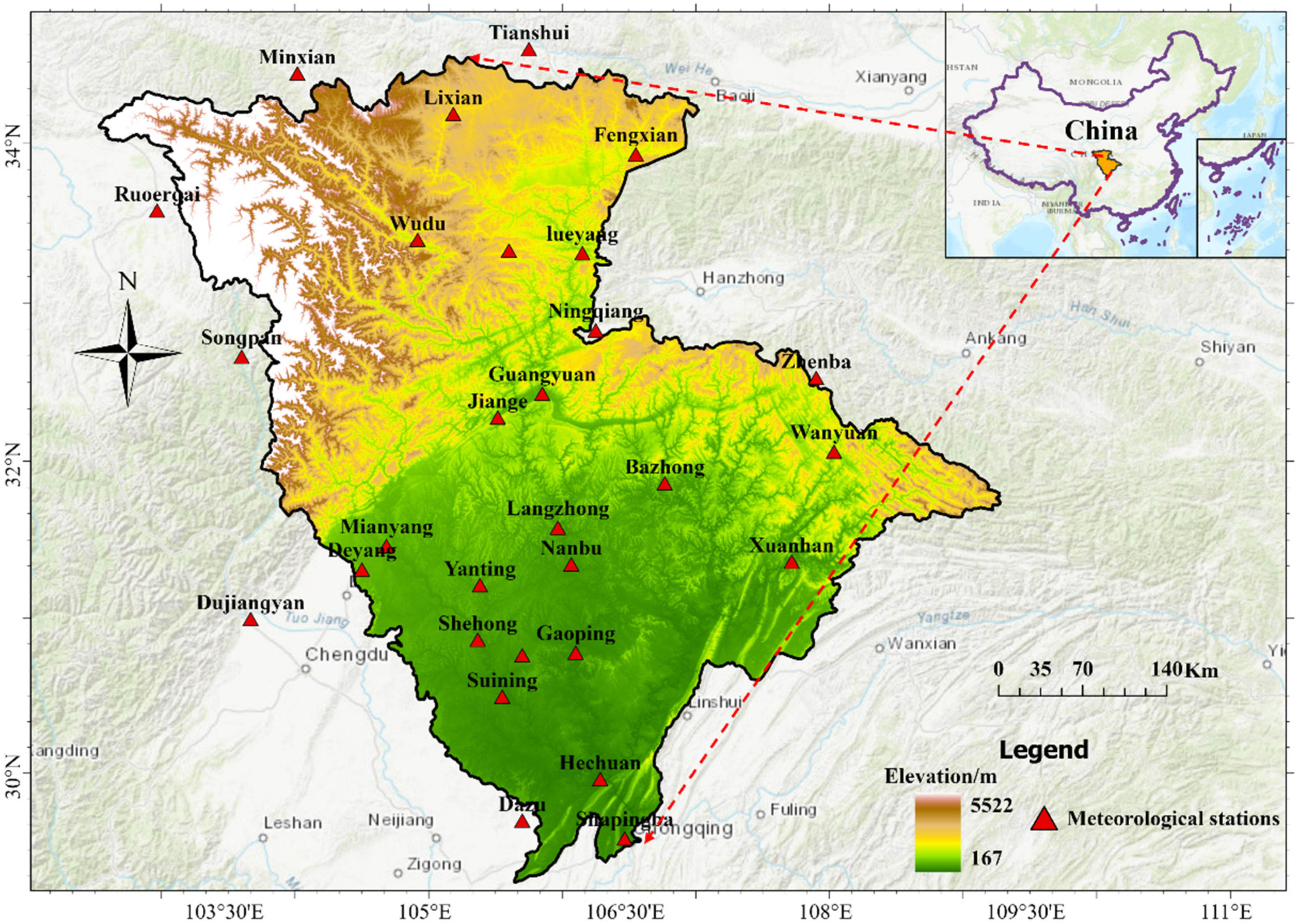
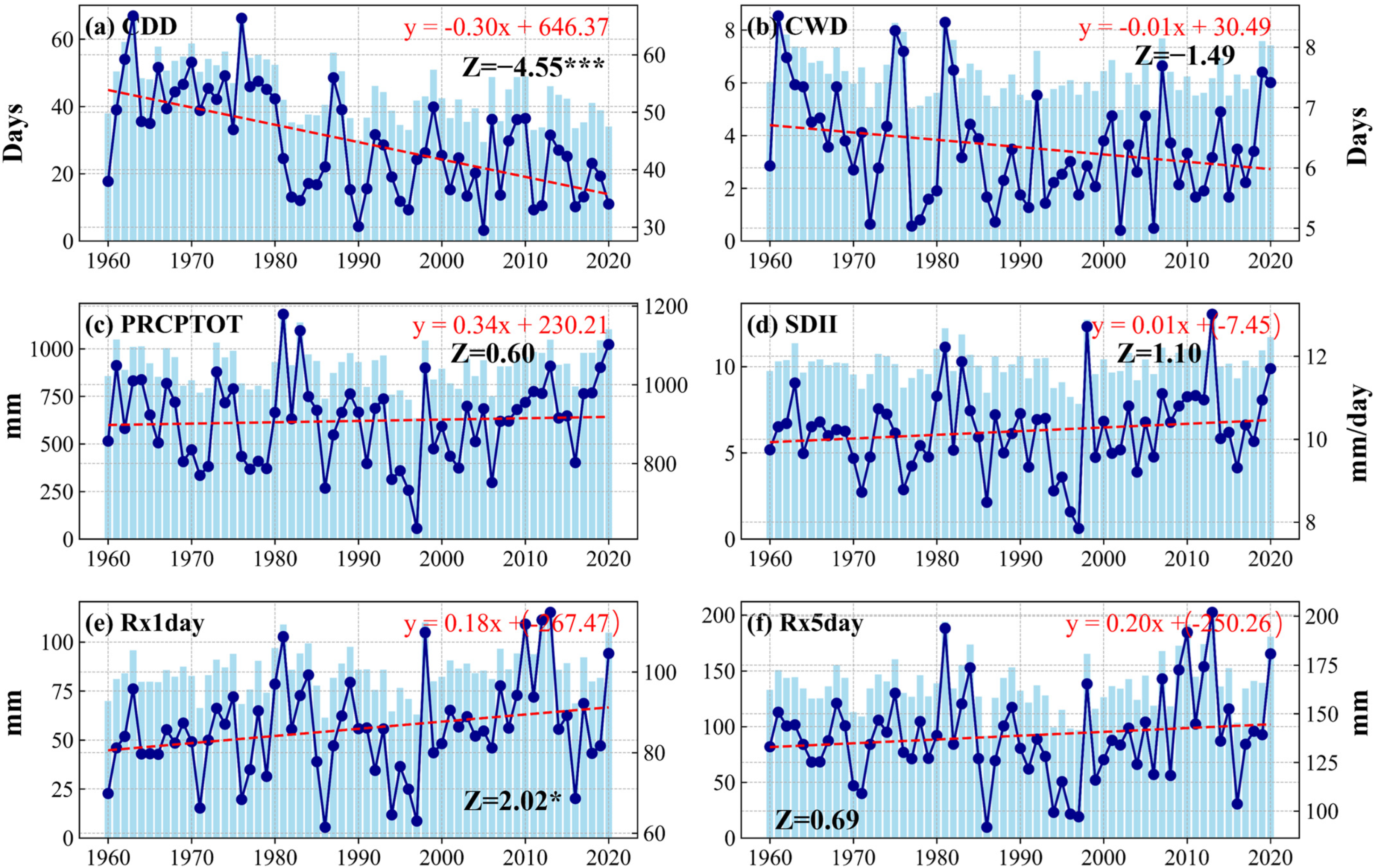


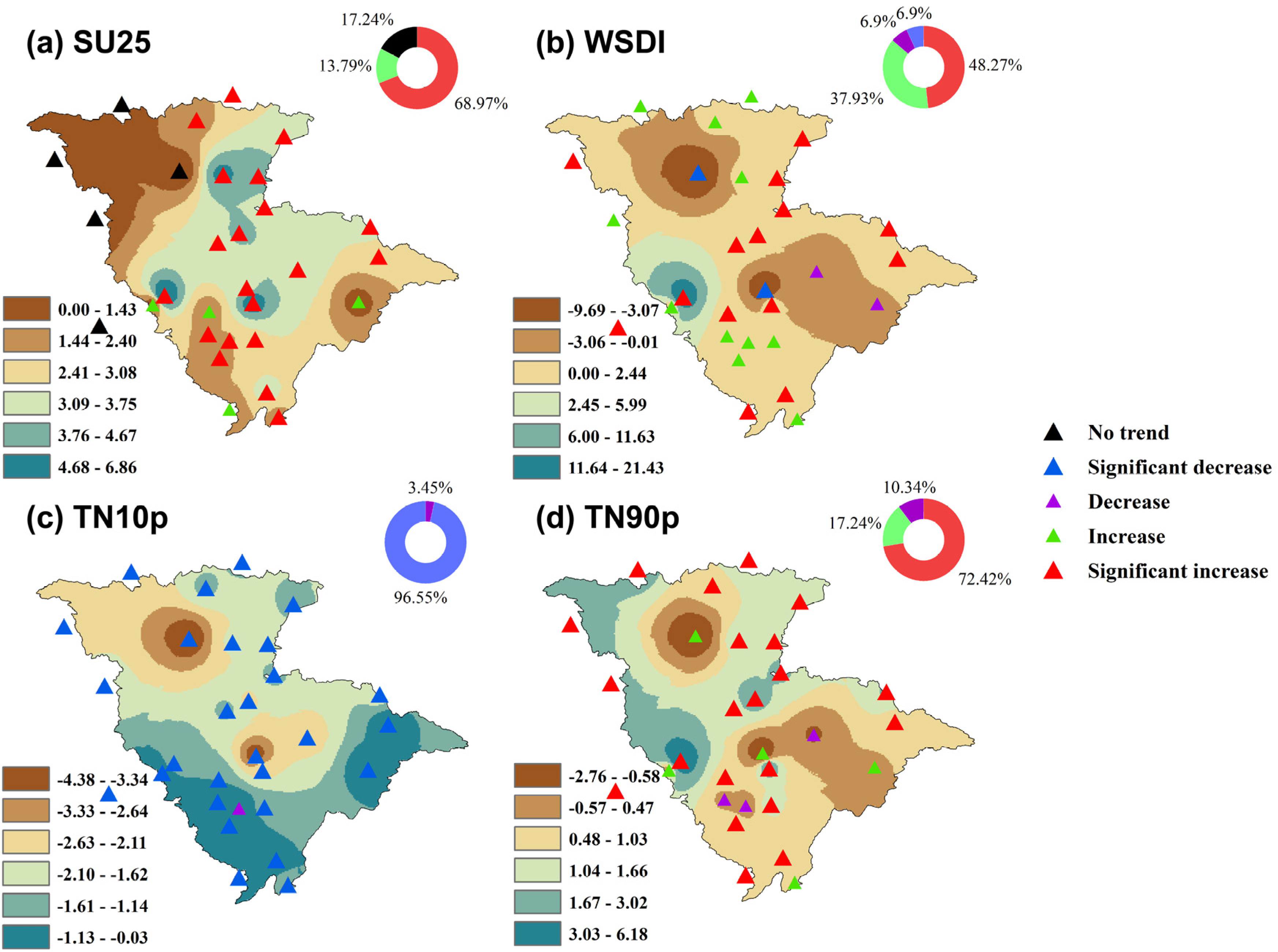
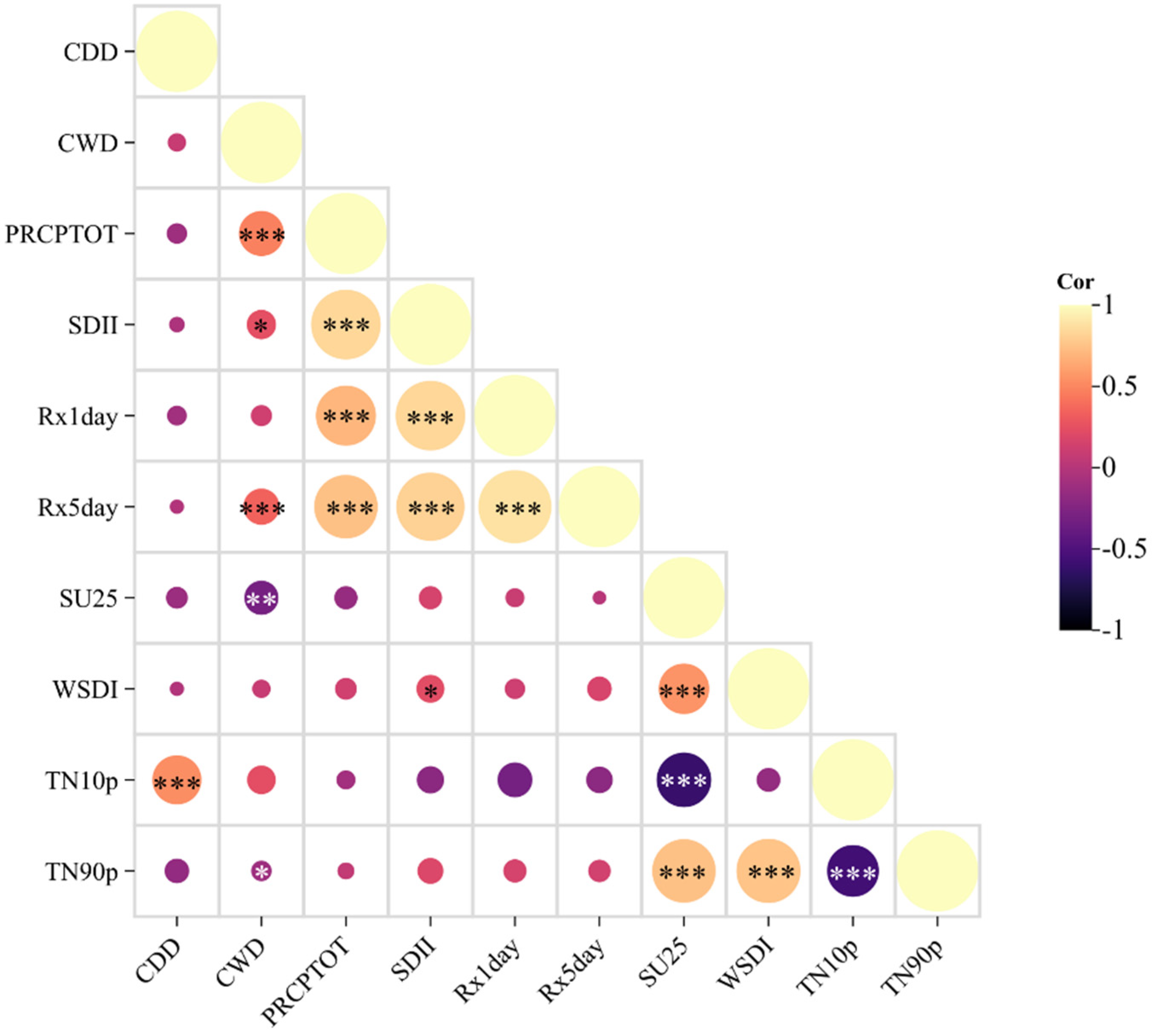
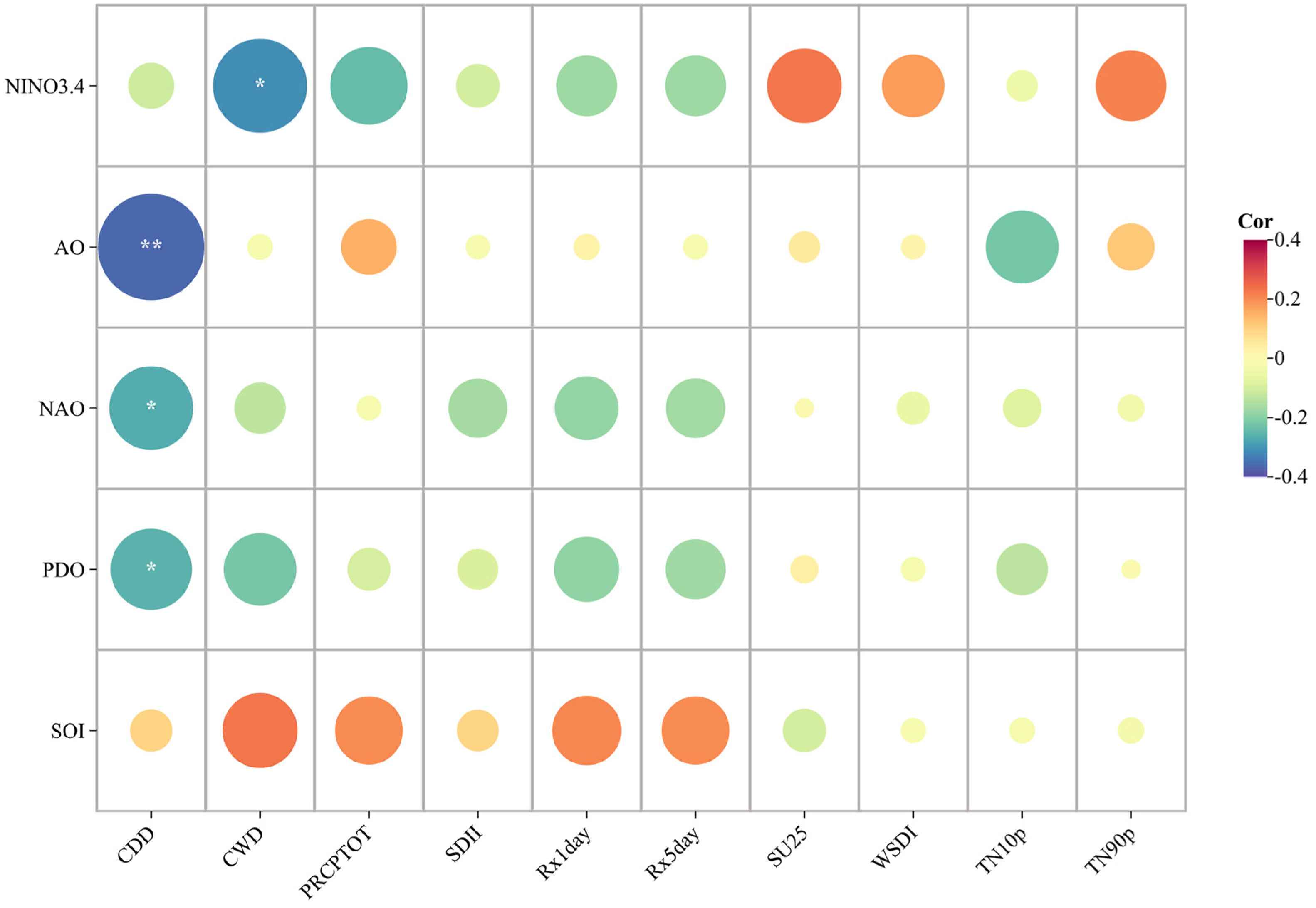


| Station ID | Station Name | Lat/N | Lon/E | Elevation/m |
|---|---|---|---|---|
| 56,079 | Ruoergai | 33.35 | 102.58 | 3441.4 |
| 56,093 | Minxian | 34.26 | 104.01 | 2315 |
| 56,096 | Wudu | 33.24 | 104.55 | 1079.1 |
| 56,182 | Songpan | 32.40 | 103.36 | 2850.7 |
| 56,188 | Dujiangyan | 31.00 | 103.40 | 698.5 |
| 56,196 | Mianyang | 31.47 | 104.68 | 522.7 |
| 57,106 | lueyang | 33.19 | 106.09 | 794.2 |
| 57,206 | Guangyuan | 32.26 | 105.51 | 513.8 |
| 57,211 | Ningqiang | 32.50 | 106.15 | 836.1 |
| 57,237 | Wanyuan | 32.04 | 108.02 | 674 |
| 57,238 | Zhenba | 32.32 | 107.54 | 693.9 |
| 57,306 | Langzhong | 31.35 | 105.58 | 382.6 |
| 57,313 | Bazhong | 31.52 | 106.46 | 417.7 |
| 57,314 | Nanbu | 31.21 | 106.04 | 405.7 |
| 57,405 | Suining | 30.30 | 105.33 | 355 |
| 57,411 | Gaoping | 30.47 | 106.06 | 309.7 |
| 57,502 | Dazu | 29.42 | 105.42 | 394.7 |
| 57,512 | Hechuan | 29.58 | 106.17 | 230.6 |
| 57,516 | Shapingba | 29.35 | 106.28 | 259.1 |
| 57,326 | Xuanhan | 31.22 | 107.43 | 344.9 |
| 57,113 | Fengxian | 33.54 | 106.32 | 985.9 |
| 57,105 | Kangxian | 33.20 | 105.36 | 1221.2 |
| 57,007 | Lixian | 34.11 | 105.11 | 1404.6 |
| 57,006 | Tianshui | 34.35 | 105.45 | 1141.6 |
| 57,308 | Yanting | 31.13 | 105.23 | 421.3 |
| 57,401 | Shehong | 30.52 | 105.22 | 383.3 |
| 57,402 | Pengxi | 30.46 | 105.42 | 394.5 |
| 56,198 | Deyang | 31.19 | 104.30 | 525.7 |
| 57,208 | Jiange | 32.17 | 105.31 | 544.5 |
| Indices | Description | Definition | Units |
|---|---|---|---|
| CDD | Continuous Dry Days | Maximum number of consecutive dry days | day |
| CWD | Continuous Wet Days | Maximum number of consecutive wet days | day |
| PRCPTOT | Annual precipitation | Total precipitation on rainy days (daily precipitation ≥ 1 mm) within a year | mm |
| SDII | Average daily precipitation intensity | The ratio of the total precipitation amount ≥ 1 mm to the number of days | mm |
| Rx1day | The maximum daily precipitation amount | The maximum daily precipitation within one year | mm |
| RX5day | The maximum precipitation in 5 days | Maximum precipitation > 5 consecutive days | mm |
| SU25 | Number of summer days | Number of days with a maximum temperature > 25 °C | day |
| WSDI | Consecutive warm days | Annual count of days with at least 6 consecutive days when TX > 90th percentile | day |
| TN10p | Cool nights count | Number of days with daily minimum temperature < 10th percentile value | day |
| TN90p | Number of warm nights | Number of days with daily minimum temperature > 90th percentile | day |
| Climate Index | Meaning | Category |
|---|---|---|
| SOI | Calculated based on the difference in sea level pressure between Tahiti and Darwin | Sea surface pressure |
| NAO | Calculation is derived from the sea level pressure difference between the Azores high and the Iceland low | Sea surface pressure |
| AO | Estimated based on the daily sea level atmospheric pressure anomalies north of the 20° N latitude | Sea surface pressure |
| PDO | Derived from the monthly sea surface temperature anomalies in the North Pacific (north of 20° N) | Sea surface temperature |
| Niño 3.4 | Niño 3.4 refers to the sea surface temperature in the equatorial Pacific (120~170° W, 5° N~5° S) | Sea surface temperature |
Disclaimer/Publisher’s Note: The statements, opinions and data contained in all publications are solely those of the individual author(s) and contributor(s) and not of MDPI and/or the editor(s). MDPI and/or the editor(s) disclaim responsibility for any injury to people or property resulting from any ideas, methods, instructions or products referred to in the content. |
© 2024 by the authors. Licensee MDPI, Basel, Switzerland. This article is an open access article distributed under the terms and conditions of the Creative Commons Attribution (CC BY) license (https://creativecommons.org/licenses/by/4.0/).
Share and Cite
Liao, L.; Rad, S.; Dai, J.; Shahab, A.; Mo, J.; Qi, S. Spatial and Temporal Variations’ Characteristics of Extreme Precipitation and Temperature in Jialing River Basin—Implications of Atmospheric Large-Scale Circulation Patterns. Water 2024, 16, 2504. https://doi.org/10.3390/w16172504
Liao L, Rad S, Dai J, Shahab A, Mo J, Qi S. Spatial and Temporal Variations’ Characteristics of Extreme Precipitation and Temperature in Jialing River Basin—Implications of Atmospheric Large-Scale Circulation Patterns. Water. 2024; 16(17):2504. https://doi.org/10.3390/w16172504
Chicago/Turabian StyleLiao, Lin, Saeed Rad, Junfeng Dai, Asfandyar Shahab, Jianying Mo, and Shanshan Qi. 2024. "Spatial and Temporal Variations’ Characteristics of Extreme Precipitation and Temperature in Jialing River Basin—Implications of Atmospheric Large-Scale Circulation Patterns" Water 16, no. 17: 2504. https://doi.org/10.3390/w16172504
APA StyleLiao, L., Rad, S., Dai, J., Shahab, A., Mo, J., & Qi, S. (2024). Spatial and Temporal Variations’ Characteristics of Extreme Precipitation and Temperature in Jialing River Basin—Implications of Atmospheric Large-Scale Circulation Patterns. Water, 16(17), 2504. https://doi.org/10.3390/w16172504







